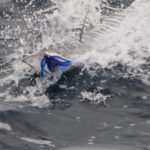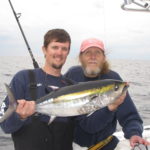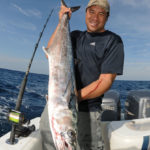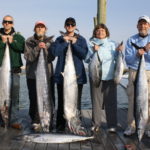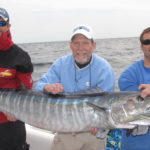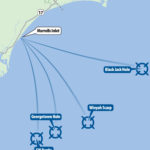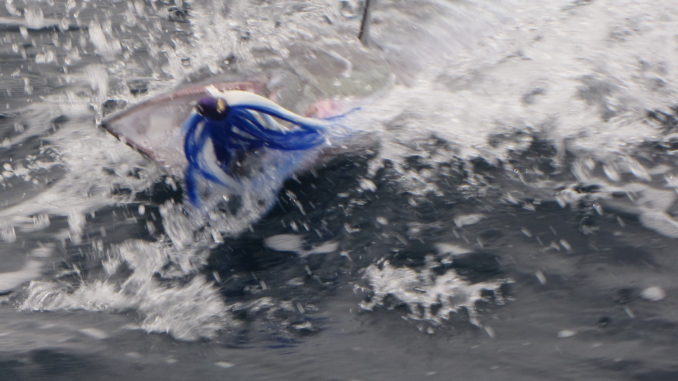
Murrells Inlet gives excellent access to Georgetown Hole and other bluewater hot spots.
By November, the tourist action has slowed down in Murrells Inlet and the surrounding Grand Strand, but the offshore fishing action is fast and furious.
For Dallas Dellinger and Ned Rogers, the captains who operate R&R Charters, hours and hours of trolling are broken by moments of madness when one of them will shout, “Fish on! Fish on! Clear the rods! Keep reeling no matter what!”
Then the fun really starts.
While November draws lots of fishermen to deer stands across South Carolina, the change of seasons draws plenty of fish to within range of Dellinger and Rogers and their Murrells Inlet-based boats. Water temperatures might drop from the low-70s at the first of the month to the mid-60s by Thanksgiving, and the drop opens up a great bite on wahoo, blackfin tuna and king mackerel, with an occasional dolphin showing up — although they have usually moved to deeper water.
Wahoo are offshore year round, but they like that 65- to 75-degree water, and Dellinger said they seem to fight better in the cooler temperatures. The kings and tuna turn on best when the water temperatures are in the 70- to 75-degree range. In November, kinds and wahoo will usually be along the edge of the Gulf Stream, 40 to 60 miles from Murrells Inlet, depending on the water temperature and water depths.
Because Dellinger and Rogers, who have been fishing together for three years, usually fish from fast center-console boats powered by two or three big outboards, the trips don’t take as long as bigger charterboats that cruise between 20 and 30 miles per hour, so lines are in the water for a much longer period of time.
Where the two captains fish depends on a variety of factors, including wind, water temperatures, the moon phase and where they have been catching fish.
“Wind determines where warm water is pushed, and generally, this is governed by the southwest wind, which pushes the bait, which in turns holds fish,” Dellinger said, pointing to westerly winds of 10 mph or less being the best fishing winds in the fall.
When they get in the general area they want to fish, Rogers and Dellinger look for calm areas where currents meet, creating a rip that will likely hold bait. Scanning their depth sounders, they look for temperature changes, with the water usually being cooler on one side of the rip and warmer on the other.
“Follow the bait by finding the water temperature that the fish like, and you will find the fish,” Rogers said, nothing that temperature changes of as little as a single degree may position bait and turn on the predator fish.
The moon is also a determining factor; if it is big and bright, chances are that the bite will take place later in the morning. With a full moon or an overcast moon, the way fish feed might be affected.
From Murrells Inlet, Rogers and Dellinger like to fish well-known offshore spots, including McDougal Ledge, Winyah Scarp, the Black Jack Hole and the Southwest Banks; their all-time favorite is the Georgetown Hole, which ranges from 45 to 60 miles from Murrells Inlet, depending on exactly where they want to fish. The Georgetown Hole is a ledge that runs east to west — perpendicular to the shoreline and the Gulf Stream — for about 10 miles.
Dellinger and Rogers like to fish depths of between 150 and 200 feet in November, heading to an area, then idling around and looking for birds and bait before setting out lines. They like to check out the rip along the edge, looking for holes along any ledges, because the holes may hold warmer water in November and thus, hold fish.
The standard spread of trolled baits is made up of five lines, plus two teasers. They fish one bait down the center more than 100 feet behind the boat, farther back than any others and known as the “county” line — fished from a rocket-launcher mount atop the T-bar. It targets tuna, but all species might pick up the bait, because it comes swimming along after the fish has missed the other lures.
On the port side, the two captains like to run a bait approximately 40 feet deep on a No. 3 or No. 4 planer fished on a large, heavy rod and reel with 100 feet of stainless steel wire and 300 yards of dacron backing. A safety line is always hooked to the planer rod, and the leader between the planer and bait is usually 50 to 75 feet of 150-pound mono.
Planer rods usually target the bigger wahoo with big baits, most often horse ballyhoo. Rogers prefers them to downriggers because downrigger balls swing and bounce too much on days when seas are rougher, and he doesn’t like the “sing” that the downrigger cable makes.
On the starboard side, Dellinger and Rogers run a flat line attached to a clip on the transom, 15 to 30 yards behind the boat.
Two lines are run 50 to 75 yards behind the boat on outriggers on either side of the boat, and two teasers — a squid spreader ba and a bowling-pin teaser — are run on the inside of the outriggers and in the whitewater or prop wash.
When a fish strikes, Dellinger or Rogers will call out “Fish on! Fish on!” and a mad dash follows to clear the teasers and other lines ,especially if it looks to be a good fish.
Favorite lures for wahoo and kings include Blue Water Candy lures in black/purple/mylar, Ilanders in blue/white or sea witches with double hooks in blue/white or blue/pink for tuna. All lures are rigged with 3/8 or 1/2-ounce barrel sinkers to keep the noses of the baits down.
Lure colors often depend on which fish are being targeted, but black, blue and white are dominant colors. If bait is present in an area but nothing’s biting, Rogers and Dellinger don’t hesitate to change colors.
Remember that in November, it can be a cool ride going out, then it can turn warm in the afternoon, and the threat or rain that can cool things down very quickly is always there. Dress in layers and have a waterproof and/or insulted outfit for the ride. There is nothing more miserable than being cold and wet offshore. The old saying about weather holds true: “There is no such thing as bad weather — just bad clothing decisions.”
DESTINATION INFORMATION
WHEN TO GO/HOW TO GET THERE — Late October through Thanksgiving is an excellent time to fish offshore out of Murrells Inlet for wahoo, king mackerel and blackfin tuna. Murrells Inlet is at the southern end of the Grand Strand, best accessed by US 17 from north and south. From areas of the Midlands and Upstate, you have to come in through Conway and/or Georgetown, because there are no bridges across the series of rivers that flow south from the North Carolina border to Georgetown.
TACKLE/TECHNIQUES — Trolling outfits in the 30- to 50-class are common when targeting wahoo, blackfin tuna and king mackerel. Lures like Blue Water Candy and Ilanders are common, along with ballyhoo and horse ballyhoo trolled behind sea witches. Look for temperature breaks and current rips that often hold bait.
GUIDES/FISHING INFO — Capt. Ned Rogers/Capt. Dallas Dellinger, R&R Charters, 843-460-0186 or 843-333-5336, www.murrelsinletfishingsc.com; Crazy Sister Marina, 843-651-4285; Marlin Quay Marina, 843-651-4444. See also Guides and Charters in Classifieds.
ACCOMMODATIONS — Brookwood Inn, Murrells Inlet, 843- 651-2550, www.staybrookwoodinn.com; Hampton Inn, Murrells Inlet, 800-992-2684; Holiday Inn, Murrells Inlet, 866-460-7842; The Inlet Sports Lodge, Murrells Inlet, 877-585-9360, www.InletSportsLodge.com. For camping, Huntington Beach State Park, Murrells Inlet, 843-237-4440.
MAPS — Capt. Segull’s Nautical Charts, 888-473-4855, www.captainsegullcharts.com; Sealake Fishing; Guides, 800-411-0185, www.thegoodspots.com; Maps Unique, 910-458-9923, www.mapsunique.com.

